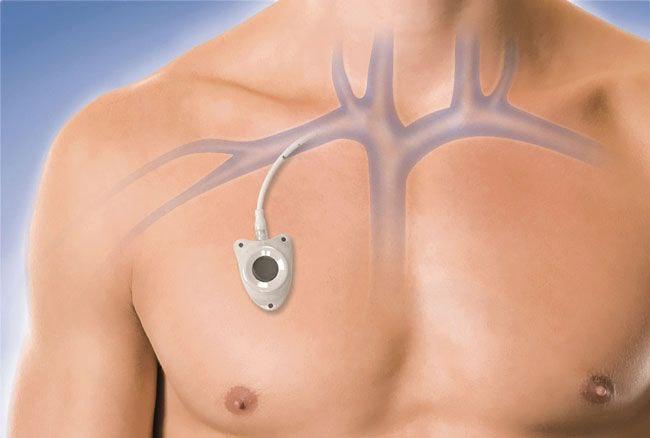It is no secret that conduction of chemotherapy sessions is not one of the "most pleasant" procedures. Adding fuel to the fire is the fact that the course of polychemotherapy requires constant intravenous access to administer the necessary drugs. Multiple venipunctures can lead to serious complications, for example, vein thrombophlebitis development, closure of its lumen, leakage of cytostatic drug into the space around vein, which causes inflammation and necrosis (death) of soft tissues around vein. Accordingly, these complications significantly limit the ability to continue life-saving treatment and create additional problems for patient.
Therefore, surgeons of our clinic can install a special port system for multiple infusions in such patients. This will prevent described complications, as well as make a course of chemotherapy more comfortable for patient. Maimonides Center is one of the few in Ukraine where such infusion port systems are implanted. In our medical center ports installation is carried out by experienced surgeons in conditions of a sterile, modern operating room under short-term intravenous anesthesia, which meets the requirements of international standards.
We recommend infusion port system implantation to all our oncology patients before the start of treatment to ensure a comfortable and painless administration of chemotherapy drugs.
Port and catheter – what is the difference? What are the advantages of port systems?
Many patients know about such a device for intravenous infusions as a catheter. What is the difference between a regular catheter and a port system? Catheter is a system made of plastic in the form of a thin tube located in vein, and a place for connecting a syringe and injecting drugs. With the help of catheter, a permanent connection of vein with external environment is formed. This requires proper care of the catheter and significantly limits patient's activity. Catheter service life does not exceed a few days, as it is often dislodged, infected or thrombosed.
Unlike a catheter, port is placed under patient's skin and does not have a direct connection with external environment, so it does not require special care. The part of port is located in vein and is covered with a special bioinert material. Thanks to which a good prevention of thrombus formation at port implantation site and absence of body reactions to foreign material is achieved. Port can be installed on patient for a long period of time – up to 3-5 years, after which it is either removed or replaced with a new one. Port does not limit patient's activity in any way: in everyday life, you can do sports, take a shower, take a bath, swim, travel, etc., without fear of displacing or damaging the port system.
Due to described advantages of port systems, our specialists actively recommend their implantation for oncology patients to ensure comfortable, effective and continuous treatment, as well as blood sampling for necessary laboratory tests during therapy course.
What is an infusion port system? How to take care of it?
The port consists of 2 main parts:
- a catheter that is installed in lumen of large vein;
- tank made of titanium, covered from inside with a bioinert polymer.
The reservoir is installed and subsequently located subcutaneously. It has a special membrane on top, through which, by piercing skin and the membrane itself with a special needle (Huber's needle), the necessary drugs are injected. System is completely isolated from external environment and protected from infection.
As a rule, port is installed under skin in subclavian area or in area of the right or left forearm. Port system installation site is selected taking into account the patient's general condition, comprehensive treatment program, and lifestyle.
Port system doesn’t require any special care. It is completely invisible under skin, but is easily palpable. In thin people, the port may be somewhat noticeable in the form of skin bump with a diameter of 4-4.5 cm. There are no age restrictions on port systems installation, that is, it is suitable for both adults and children of all ages.
Importantly! There are no warnings or contraindications for performing CT and MRI in patients with installed ports, because they are made of special materials and do not affect performance or outcome of these diagnostic imaging methods.
If you have any questions about infusion port systems installation at Maimonides Medical Center or you want to know more detailed information, contact us by phone numbers and contacts indicated on the website.



